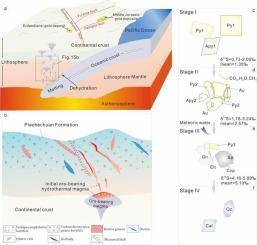Ore genesis of the Erdaodianzi gold deposit in Jilin Province, Northeast China: Constraints from Re–Os isotopes and geochemistry of pyrite
IF 3.6
2区 地球科学
Q1 GEOLOGY
引用次数: 0
Abstract
The Erdaodianzi gold deposit in Jilin Province, Northeast China, is a newly discovered large-scale gold deposit within the Paleozoic metamorphic rock sequences in the eastern segment of the northern margin of the North China Craton. The mineralization process of the Erdaodianzi gold deposit can be divided into four stages: quartz–pyrite–arsenopyrite (Stage I), quartz–pyrite–arsenopyrite–pyrrhotite–native gold–chalcopyrite (Stage II), quartz–chalcopyrite–pyrite–sphalerite–galena–electrum–marcasite (Stage III) and quartz–carbonate ± pyrite (Stage IV). Stage II is the most important for gold mineralization. Pyrite is the dominant gold-bearing mineral, which can be classified into three generations (Py1 to Py3), corresponding to mineralization stage I to stage III, respectively. In order to constrain the ore genesis of the Erdaodianzi gold deposit, Re–Os isotope dating and the geochemistry of pyrite were conducted. The electron probe microanalyzer (EPMA) data of 61 pyrites indicate that the value of S/Fe in pyrites from the Erdaodianzi gold deposit is relatively low (average Py1 = 2.00, Py2 = 1.97, Py3 = 1.96), which suggests a sulfur‑deficient character associated with magmatic activity. The in situ Laser Ablation Inductively Coupled Plasma Mass Spectrometry (LA-ICP-MS) data indicate that pyrites (Py2) from the major mineralization stage are rich in Au, As, Cu, Pb, and Zn, but poor in Co, Ni, Sb, and Bi. Visible gold grains are primarily composed of native gold and electrum. The gold content in pyrite is significantly below the gold solubility limit, indicating that invisible gold exists in the pyrite lattice in the form of Au+. In the Erdaodianzi gold deposit, fluid boiling and immiscibility led to the escape of volatiles and oxygen fugacity (fO2) in the ore-forming fluids decreased, causing the instability of the Au(HS)2− complex, which promotes the precipitation of gold and the formation of gold-bearing sulfides. In this study, the sulfur isotopic values of pyrites (Py1 = 0.73 ‰–2.05 ‰, Py2 = 1.78 ‰–3.24 ‰, Py3 = 4.16 ‰–5.89 ‰) indicates that the mineralization materials of the Erdaodianzi gold deposit mainly originate from magma. Additionally, the high Co/Ni ratio indicates that the pyrite is a magmatic-hydrothermal source. The Re–Os isotopic dating of five pyrites (Py2) from the Erdaodianzi gold deposit yield an isochron age of 172 ± 3 Ma (MSWD = 0.29) and the weighted average of the model ages is 172 ± 2 Ma (MSWD = 0.84), which constrains the mineralization age of the Erdaodianzi gold deposit to the Middle Jurassic. Based on all available data and regional geological, the Erdaodianzi gold deposit is a Middle Jurassic mesothermal magmatic-hydrothermal vein-type gold deposit. Comparative studies of the Erdaodianzi gold deposit and other gold deposits on the Jiapigou–Haigou gold belt (JHGB), it is confirmed that they are similar in terms of ore genesis and associated with the subduction of the Paleo-Pacific Plate during the Middle Jurassic. This suggests that the JHGB extends northwestward, providing a theoretical basis for new regional exploration directions.

吉林二道店子金矿床矿石成因:来自Re-Os同位素和黄铁矿地球化学的约束
吉林省二道店子金矿床是华北克拉通北缘东段古生代变质岩系内新发现的大型金矿床。二道店子金矿床的成矿过程可分为4个阶段:石英-黄铁矿-毒黄铁矿(阶段1)、石英-黄铁矿-毒黄铁矿-磁黄铁矿-原生金黄铜矿(阶段2)、石英-黄铜矿-黄铁矿-闪锌矿-方铅矿-镁黄铁矿(阶段3)和石英-碳酸盐岩±黄铁矿(阶段4)。第二阶段是金矿化最重要的阶段。黄铁矿为主要含金矿物,可划分为Py1 ~ Py3三代,分别对应ⅰ~ⅲ期成矿作用。为了约束二道店子金矿床的矿床成因,进行了Re-Os同位素定年和黄铁矿地球化学研究。电子探针显微分析(EPMA)结果表明,二道店子金矿床黄铁矿中S/Fe值较低(平均Py1 = 2.00, Py2 = 1.97, Py3 = 1.96),具有与岩浆活动有关的缺硫特征。原位激光烧蚀电感耦合等离子体质谱(LA-ICP-MS)数据表明,主成矿期黄铁矿(Py2)富含Au、As、Cu、Pb和Zn,而Co、Ni、Sb和Bi含量较低。可见金颗粒主要由天然金和银金组成。黄铁矿中金的含量明显低于金的溶解度极限,表明黄铁矿晶格中存在以Au+形式存在的看不见的金。二道店子金矿床流体沸腾和不混溶导致成矿流体中挥发物逸出,氧逸度(fO2)降低,导致Au(HS)2−络合物不稳定,促进了金的沉淀和含金硫化物的形成。本研究黄铁矿硫同位素值(Py1 = 0.73‰~ 2.05‰,Py2 = 1.78‰~ 3.24‰,Py3 = 4.16‰~ 5.89‰)表明二道店子金矿成矿物质主要来源于岩浆。高Co/Ni比值表明黄铁矿为岩浆-热液源。二道店子金矿床5颗黄铁矿(Py2)的Re-Os同位素定年结果显示,等时线年龄为172±3 Ma (MSWD = 0.29),模式年龄加权平均值为172±2 Ma (MSWD = 0.84),限定了二道店子金矿床成矿时代为中侏罗统。综合现有资料和区域地质资料,认为二道店子金矿床为中侏罗统中温岩浆-热液脉型金矿床。通过对二道店子金矿床与夹皮沟—海沟金矿带(JHGB)上其他金矿床的对比研究,证实了二道店子金矿床与中侏罗统古太平洋板块俯冲有关,在矿床成因上具有相似性。这表明JHGB向西北延伸,为新的区域勘探方向提供了理论依据。
本文章由计算机程序翻译,如有差异,请以英文原文为准。
求助全文
约1分钟内获得全文
求助全文
来源期刊

Ore Geology Reviews
地学-地质学
CiteScore
6.50
自引率
27.30%
发文量
546
审稿时长
22.9 weeks
期刊介绍:
Ore Geology Reviews aims to familiarize all earth scientists with recent advances in a number of interconnected disciplines related to the study of, and search for, ore deposits. The reviews range from brief to longer contributions, but the journal preferentially publishes manuscripts that fill the niche between the commonly shorter journal articles and the comprehensive book coverages, and thus has a special appeal to many authors and readers.
 求助内容:
求助内容: 应助结果提醒方式:
应助结果提醒方式:


